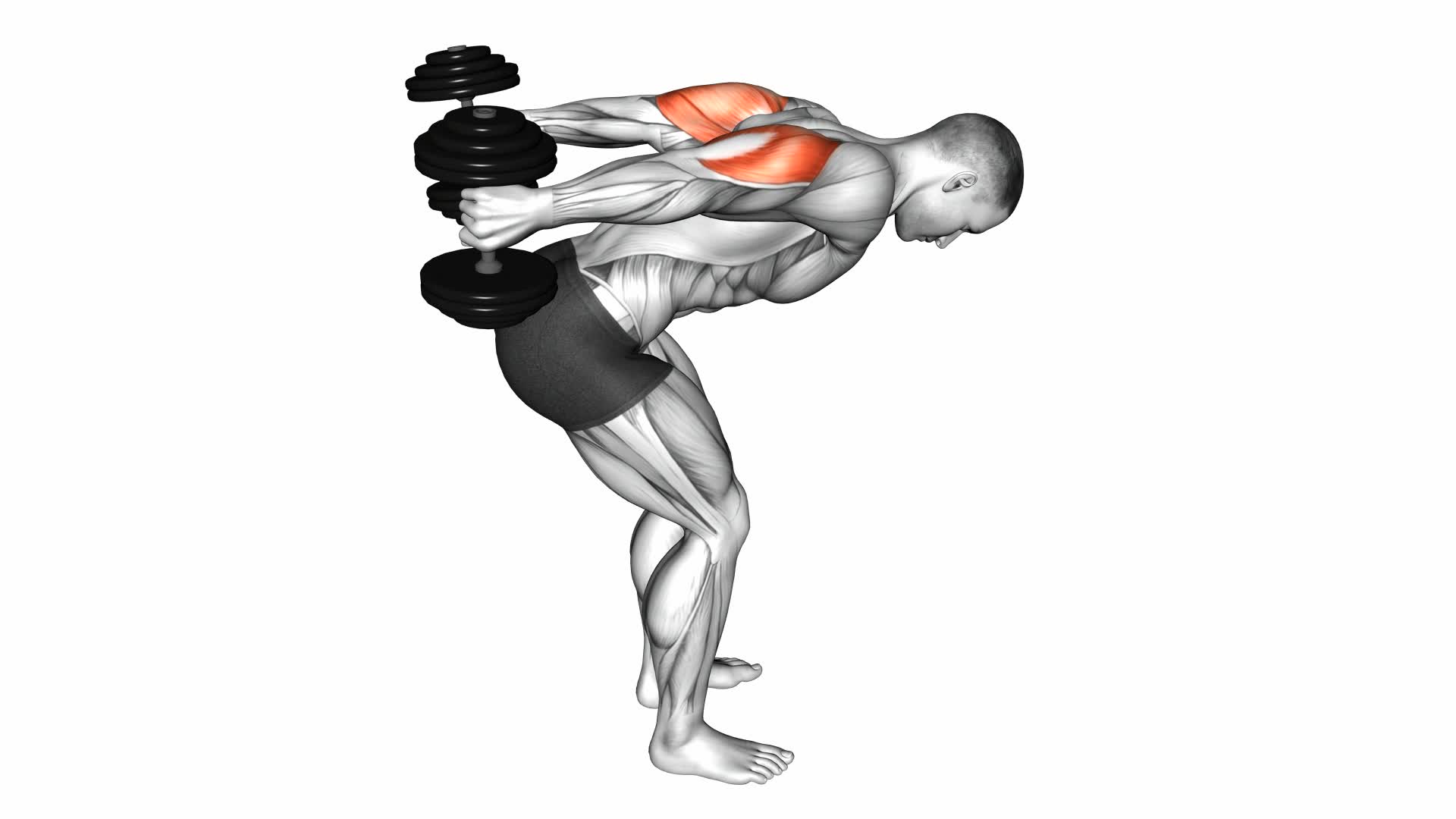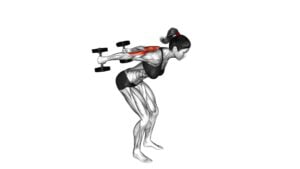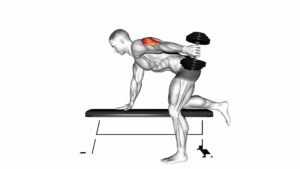Dumbbell Standing Kickback – Video Exercise Guide & Tips

Get ready to tone and strengthen your arms with the Dumbbell Standing Kickback!
Watch This Exercise Video
In this video exercise guide, we'll show you how to perform this effective exercise for targeting your triceps.
With proper equipment and setup, you'll learn the step-by-step technique to get the most out of this move.
We'll also share common mistakes to avoid, variations for all fitness levels, and tips for maximizing results and preventing injury.
Let's get started!
Key Takeaways
- The dumbbell standing kickback exercise is effective for increasing strength and definition in the triceps.
- Proper form and weight selection are crucial for maximizing results and preventing injury.
- The exercise can be modified for different fitness levels, with beginner-friendly modifications and advanced variations available.
- Gradual progression and focusing on proper form are important for building strength and avoiding common mistakes.
Benefits of the Dumbbell Standing Kickback
You will experience increased strength and definition in your triceps with the dumbbell standing kickback. This exercise is highly beneficial as it specifically targets the triceps, helping you achieve toned and sculpted arms. By performing the dumbbell standing kickback, you engage the muscles in the back of your upper arms, resulting in improved muscle tone and increased overall arm strength.
One of the key benefits of this exercise is its ability to isolate and target the triceps. Unlike other exercises that also engage the chest or shoulders, the dumbbell standing kickback solely focuses on the triceps, allowing for maximum muscle activation and growth. This targeted approach is especially beneficial for those looking to achieve well-defined and sculpted arms.
In addition to building strength and definition, the dumbbell standing kickback also helps improve muscle endurance. By performing multiple repetitions of this exercise, you challenge your triceps to work harder and for longer periods of time. This increased endurance not only enhances your overall fitness level but also allows you to perform daily activities with greater ease.
Now that you understand the benefits of the dumbbell standing kickback, it's important to ensure proper equipment and setup to maximize its effectiveness.
Proper Equipment and Setup
To ensure a successful dumbbell standing kickback, there are a few key points to consider.
First, choose the ideal dumbbell weight that challenges your muscles without compromising form.
Second, watch a proper form demonstration to learn the correct technique.
Ideal Dumbbell Weight
Choose the appropriate dumbbell weight for the standing kickback exercise to ensure proper equipment and setup. The dumbbell weight you choose will depend on your fitness level and strength.
Here are a few things to consider when selecting the ideal dumbbell weight:
- Start with a lighter weight: If you're new to this exercise or unsure of your strength, it's better to start with a lighter dumbbell weight. This will allow you to focus on proper technique and gradually increase the weight as you get stronger.
- Challenge yourself: On the other hand, if you're experienced and looking for a challenge, choose a heavier dumbbell weight. This will help to engage your muscles more effectively and promote muscle growth.
- Listen to your body: Pay attention to how your body feels during the exercise. If the weight feels too heavy or causes pain or discomfort, it's important to decrease the weight to avoid injury.
By selecting the appropriate dumbbell weight, you'll be able to perform the standing kickback exercise with proper technique and maximize your results.
Now, let's move on to the next section where we'll demonstrate proper form.
Proper Form Demonstration
Now that you've selected the ideal dumbbell weight, how can you properly set up and perform the standing kickback exercise?
The dumbbell standing kickback offers various benefits, including targeting the triceps and improving arm strength. To ensure proper form demonstration, start by standing with your feet shoulder-width apart and holding a dumbbell in each hand. Bend your knees slightly and hinge forward at the hips, keeping your back straight. Engage your core and maintain a neutral spine throughout the exercise.
With your elbows bent at a 90-degree angle, extend your arms straight back, squeezing your triceps at the top of the movement. Remember to keep your upper arms close to your sides and avoid swinging the weights.
As you finish the movement, transition smoothly into the next section, the necessary equipment checklist.
Necessary Equipment Checklist
First, gather the necessary equipment and set up for the dumbbell standing kickback exercise. To ensure a successful workout, make sure you have the following items:
- Dumbbells: Choose a weight that challenges you but allows you to maintain proper form throughout the exercise.
- Exercise Mat: Place a mat on the floor to provide cushioning and support for your knees and hands.
- Mirror: Position a mirror in front of you to help you check your form and make adjustments as needed.
Setting up the equipment properly is essential for a safe and effective workout. Place the dumbbells within easy reach, ensuring they're secure and won't roll away during the exercise. Position the exercise mat on a flat surface, and adjust the mirror so you can see your form clearly.
Now that you have gathered the necessary equipment and set up, let's move on to the step-by-step guide to performing the dumbbell standing kickback exercise.
Step-by-Step Guide to Performing the Exercise
How can you properly perform the dumbbell standing kickback exercise? This step-by-step guide will walk you through the correct technique to ensure you get the most out of this exercise while minimizing the risk of injury.
- Begin by standing with your feet shoulder-width apart and holding a dumbbell in each hand, palms facing inward.
- Bend forward at the waist, keeping your back straight and parallel to the ground. This is your starting position.
- Keeping your upper arms close to your sides, exhale and slowly extend your forearms backward, fully contracting your triceps.
- Hold the contracted position for a brief pause, squeezing your triceps.
- Inhale as you slowly lower the dumbbells back to the starting position, maintaining control throughout the movement.
- Repeat for the desired number of repetitions.
For beginners, it's important to start with lighter weights and focus on mastering the proper form before increasing the resistance. This will help prevent injury and ensure optimal muscle engagement. Additionally, listen to your body and stop if you feel any pain or discomfort.
Now that you know how to perform the dumbbell standing kickback exercise correctly, let's move on to the common mistakes to avoid to further optimize your workout.
Common Mistakes to Avoid
To ensure optimal results and minimize the risk of injury, it's important to avoid these common mistakes when performing the dumbbell standing kickback exercise:
- Using too much weight: One of the most common mistakes people make is using weights that are too heavy. This not only puts unnecessary strain on your muscles but also increases the risk of injury. Start with lighter weights and gradually increase the resistance as you become more comfortable with the exercise.
- Swinging the arm: Another mistake to avoid is swinging your arm during the movement. This takes away the focus from the triceps and reduces the effectiveness of the exercise. Keep your upper arm stationary and use controlled movements to extend your forearm backward.
- Not maintaining proper form: Proper form is crucial for preventing injury and maximizing the benefits of the exercise. Make sure to keep your back straight, engage your core, and avoid arching or rounding your spine. Additionally, keep your shoulder blades pulled back and down throughout the movement to stabilize your upper body.
Variations and Modifications for All Fitness Levels
There are several variations and modifications of the dumbbell standing kickback exercise that can cater to different fitness levels.
If you're a beginner, there are beginner-friendly modifications that can help you ease into the exercise and build strength gradually.
On the other hand, advanced variations are available for those who are more experienced and looking for a challenge.
Additionally, the exercise can be adapted to accommodate individuals with different abilities, making it accessible to a wide range of fitness levels.
Beginner-Friendly Modifications
For beginners or those looking for modifications, try these variations and modifications for all fitness levels with the dumbbell standing kickback exercise.
- Start with lighter weights: If you're new to strength training or have limited upper body strength, begin with lighter dumbbells. This will allow you to focus on proper form and build up your strength gradually.
- Use a resistance band: If you don't have access to dumbbells, you can use a resistance band instead. Simply step on the band with one foot and hold the other end with your hand. Perform the kickback movement as usual, focusing on squeezing your triceps at the top of the movement.
- Modify for injuries: If you have any shoulder or elbow injuries, you can modify the exercise by performing a bent-arm kickback instead. Instead of fully extending your arm, keep a slight bend in your elbow throughout the movement. This will help reduce strain on the injured area while still targeting your triceps effectively.
Advanced Variations for Pros
Looking to take your dumbbell standing kickback to the next level? If you're a pro looking for a challenge, there are advanced modifications and technique refinements that can help you push yourself even further.
One advanced variation is to perform the exercise on an unstable surface, such as a Bosu ball or a balance disc. This will engage your core muscles and improve your balance and stability.
Another modification is to increase the weight of the dumbbells you're using, allowing you to build more strength in your triceps.
Additionally, you can incorporate pauses at different points in the movement to further challenge your muscles.
By incorporating these advanced modifications and technique refinements, you can continue to progress and improve your dumbbell standing kickback.
Now, let's explore how to adapt the exercise for different abilities.
Adapting for Different Abilities
To adapt the dumbbell standing kickback for different abilities, modify the exercise based on your fitness level and goals. Here are some ways to adapt the exercise:
- Adapting for injuries: If you have an injury that affects your ability to perform the kickback, you can modify the exercise by using a lighter weight or even just using your body weight. Additionally, you can reduce the range of motion or choose a different exercise that targets the same muscle group.
- Modifying for different strengths: If you're just starting out or have lower strength levels, you can begin by using a lighter weight and gradually increase the resistance as you get stronger. Alternatively, you can perform the exercise with one arm at a time, which allows for better control and focus on each side.
Tips for Maximizing Results and Preventing Injury
Maximize your results and prevent injury by maintaining proper form and using an appropriate weight for the dumbbell standing kickback exercise.
To maximize muscle engagement and get the most out of this exercise, it's important to execute it correctly. Begin by standing with your feet shoulder-width apart and holding a dumbbell in each hand. Keep your back straight and your core engaged throughout the movement.
Start by bending your knees slightly and hinging forward at the hips, maintaining a neutral spine. Next, extend your arms fully behind you, squeezing your triceps at the top of the movement. Remember to keep your elbows close to your body and avoid swinging the weights.
When choosing a weight, select one that challenges you without compromising your form. Using a weight that's too heavy can lead to injury, while using one that's too light may not provide enough resistance to effectively target your triceps.
Frequently Asked Questions
How Many Sets and Repetitions Should I Do for the Dumbbell Standing Kickback Exercise?
To determine the number of sets and repetitions for the dumbbell standing kickback exercise, you need to consider your fitness goals and current fitness level.
It's important to maintain proper form throughout the exercise to target the triceps effectively.
Common mistakes to avoid include swinging the arm and using too much weight.
Can I Use Resistance Bands Instead of Dumbbells for This Exercise?
Yes, you can definitely use resistance bands instead of dumbbells for the standing kickback exercise. Using resistance bands offers several benefits, including increased muscle activation and control throughout the movement.
Resistance bands also provide variable resistance, meaning the tension increases as you stretch the band, making the exercise more challenging. Additionally, resistance bands are portable and versatile, allowing you to perform the exercise anywhere.
Is It Necessary to Warm up Before Performing the Dumbbell Standing Kickback?
Before performing the dumbbell standing kickback, it's necessary for you to warm up. Warming up has several benefits, such as increasing blood flow to your muscles and preparing your body for the exercise. It also helps to prevent injuries and improve your overall performance.
Additionally, it's important to be aware of common mistakes to avoid while performing this exercise, such as using too much weight or swinging your arm. Focus on maintaining proper form and control throughout the movement.
Can This Exercise Help in Toning the Triceps Muscles?
Yes, the dumbbell standing kickback exercise can definitely help in toning your triceps muscles. By extending your arm backward against resistance, you're targeting the triceps specifically. The exercise activates and strengthens these muscles, leading to improved definition and tone.
Additionally, there are variations you can try to make the exercise more challenging or target different areas of the triceps. Experiment with different weights, arm angles, and grips to find what works best for you.
What Other Exercises Can I Combine With the Dumbbell Standing Kickback to Target Different Muscle Groups?
To target different muscle groups along with the dumbbell standing kickback, you can incorporate exercises like the chest press and overhead tricep extension.
The chest press works your chest muscles while also engaging your triceps.
On the other hand, the overhead tricep extension specifically targets the triceps.
Conclusion
The dumbbell standing kickback is an effective exercise for targeting the triceps and improving upper body strength. It can be done with minimal equipment and is suitable for all fitness levels.
By following proper form and avoiding common mistakes, you can maximize your results and prevent injury. Remember to consult a fitness professional if you have any concerns or questions about performing this exercise correctly.
Keep pushing yourself and enjoy the benefits of this challenging workout.

Author
Years ago, the spark of my life’s passion ignited in my mind the moment I stepped into the local gym for the first time. The inaugural bead of perspiration, the initial endeavor, the very first surge of endorphins, and a sense of pride that washed over me post-workout marked the beginning of my deep-seated interest in strength sports, fitness, and sports nutrition. This very curiosity blossomed rapidly into a profound fascination, propelling me to earn a Master’s degree in Physical Education from the Academy of Physical Education in Krakow, followed by a Sports Manager diploma from the Jagiellonian University. My journey of growth led me to gain more specialized qualifications, such as being a certified personal trainer with a focus on sports dietetics, a lifeguard, and an instructor for wellness and corrective gymnastics. Theoretical knowledge paired seamlessly with practical experience, reinforcing my belief that the transformation of individuals under my guidance was also a reflection of my personal growth. This belief holds true even today. Each day, I strive to push the boundaries and explore new realms. These realms gently elevate me to greater heights. The unique combination of passion for my field and the continuous quest for growth fuels my drive to break new ground.







